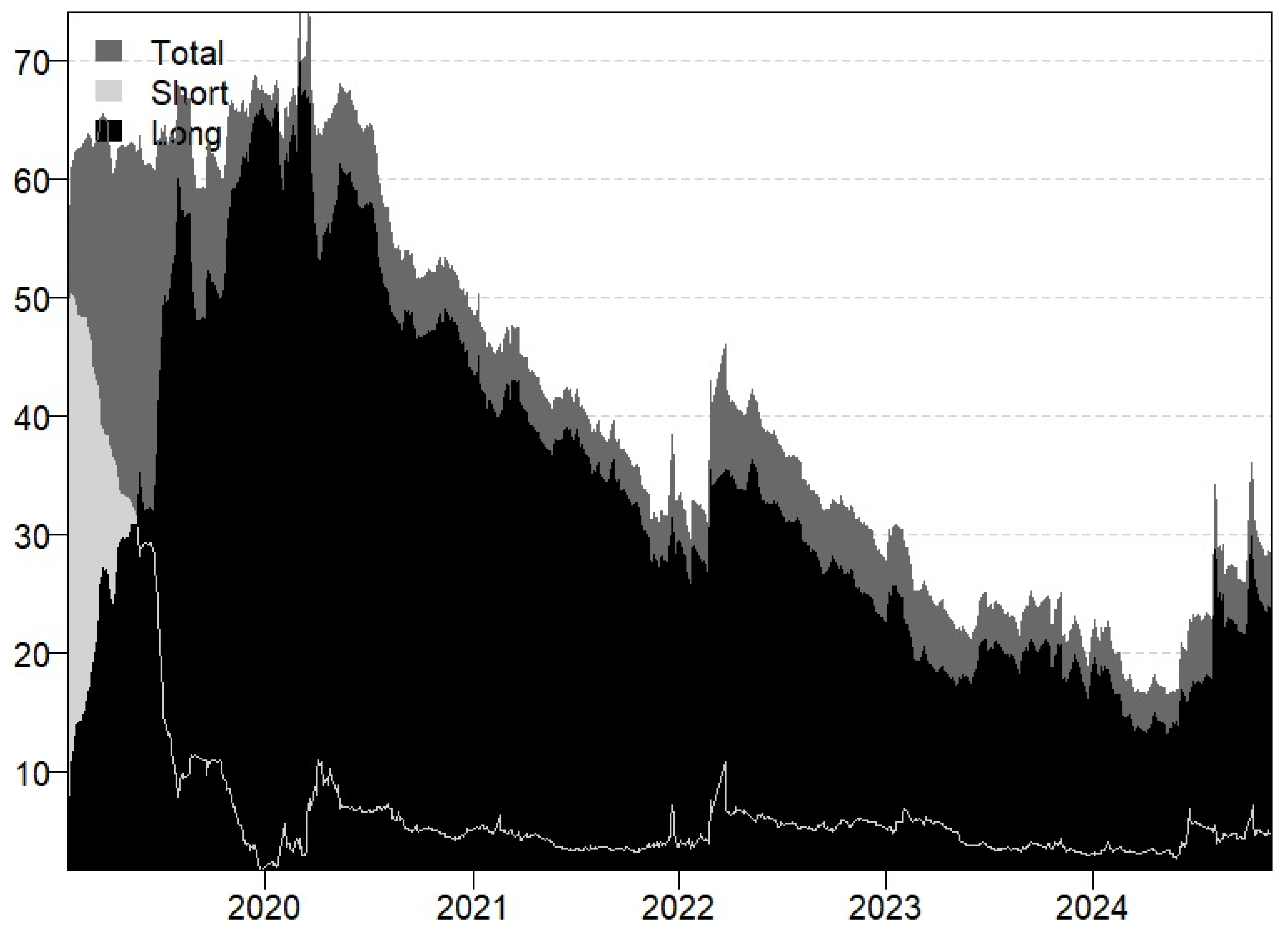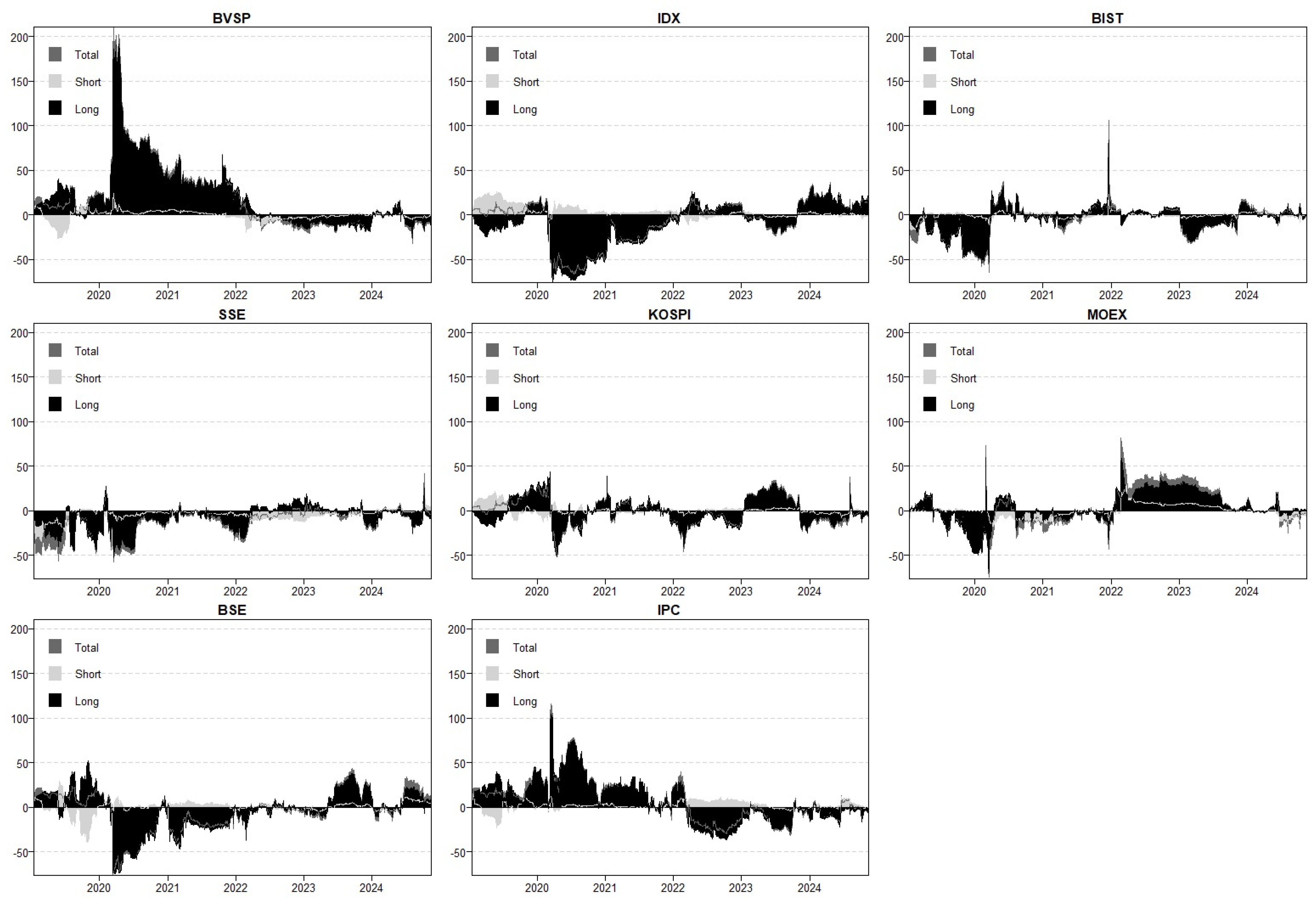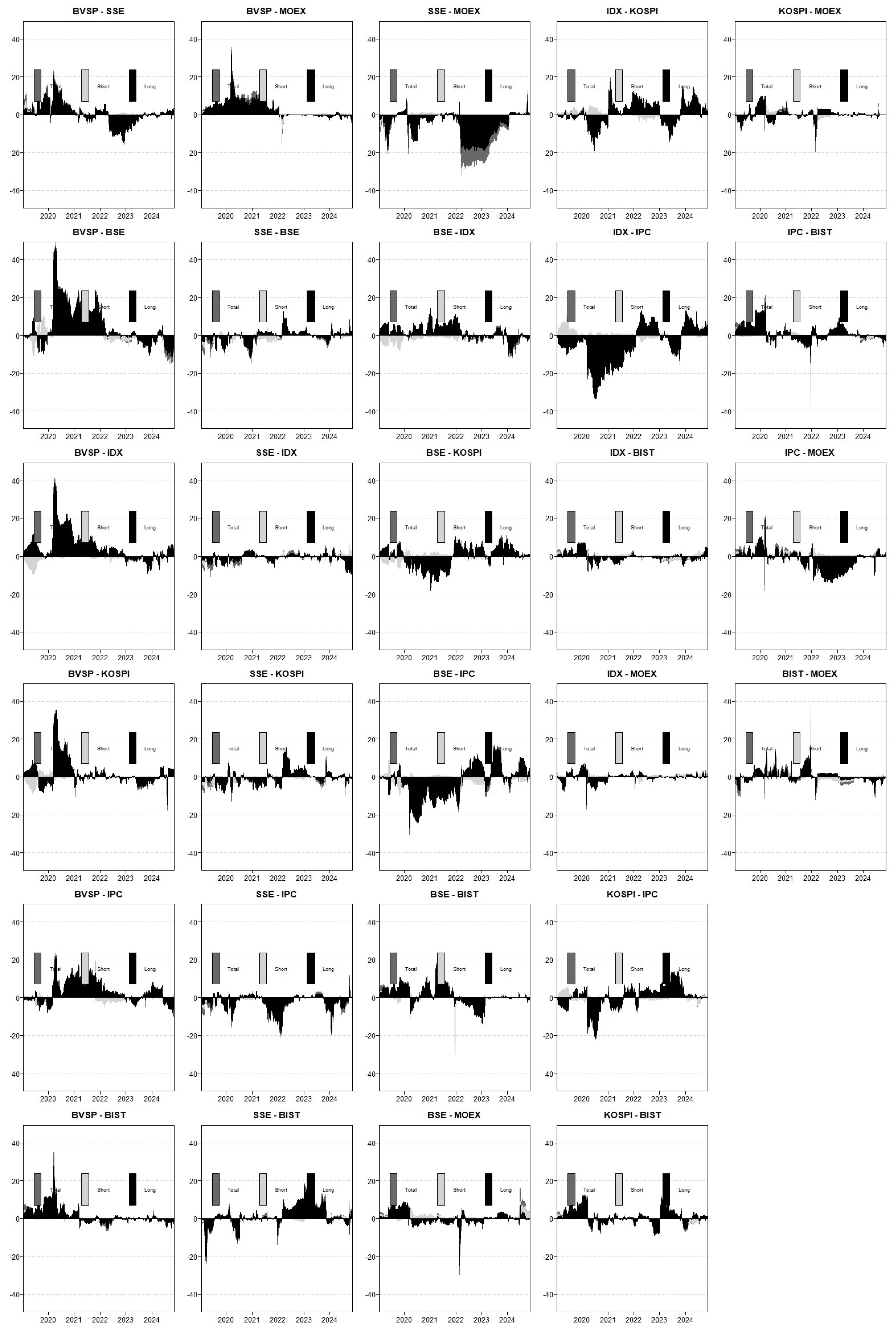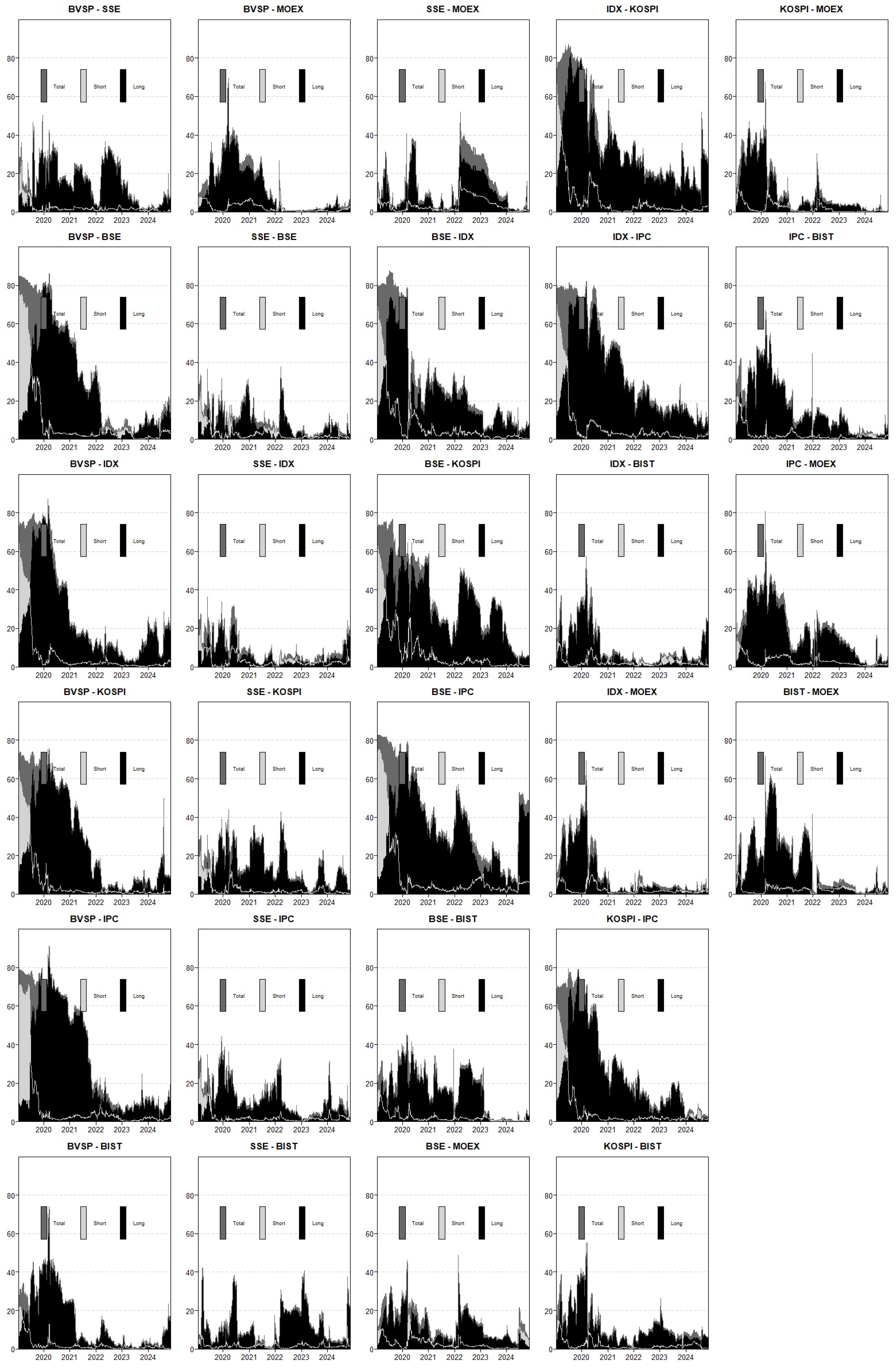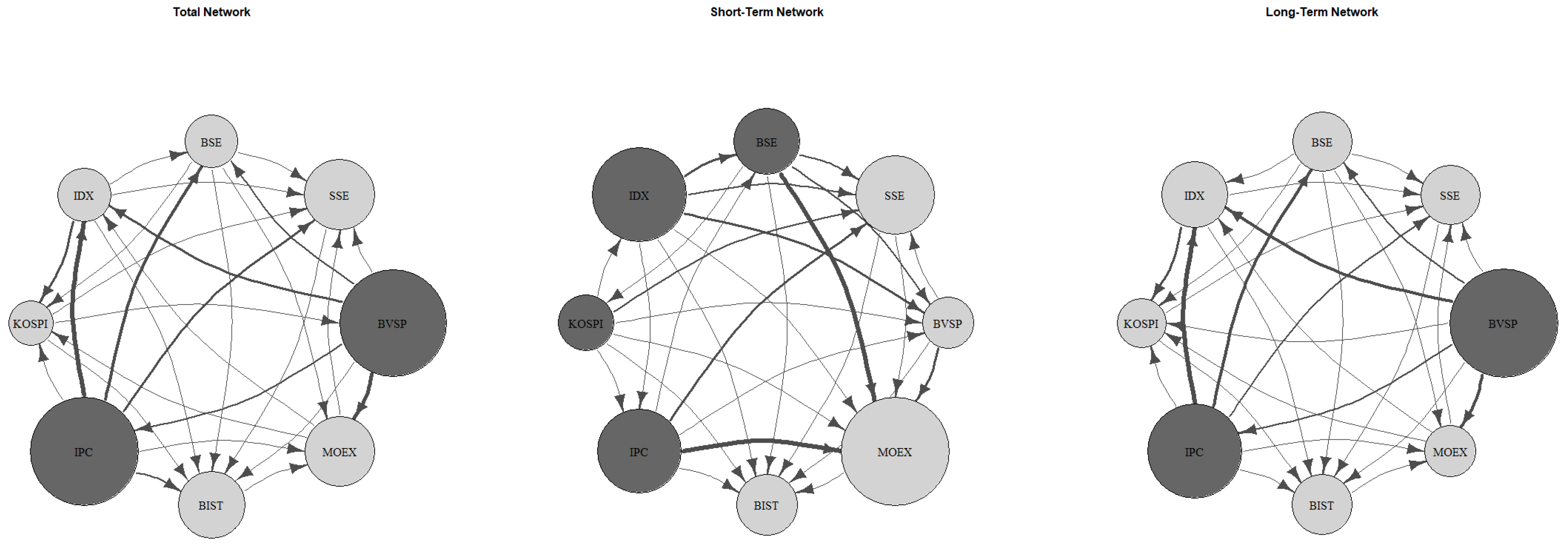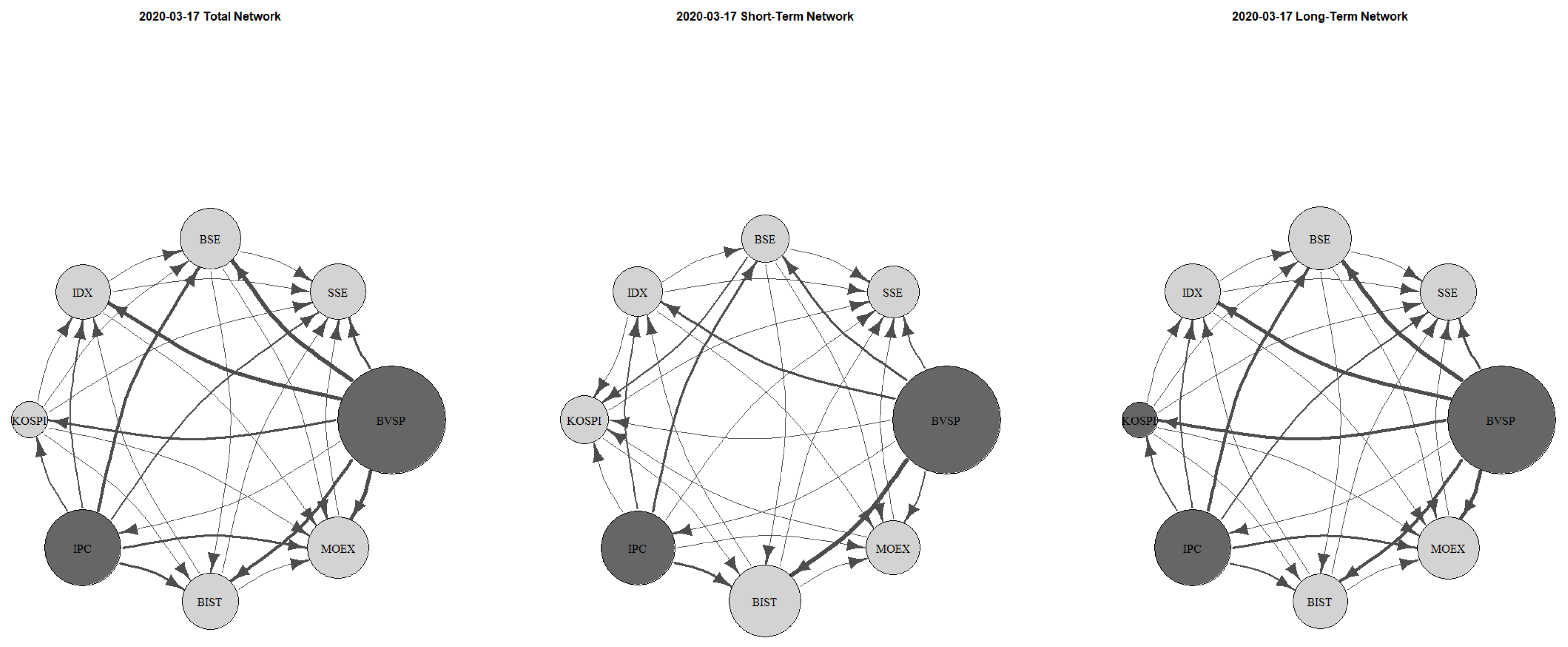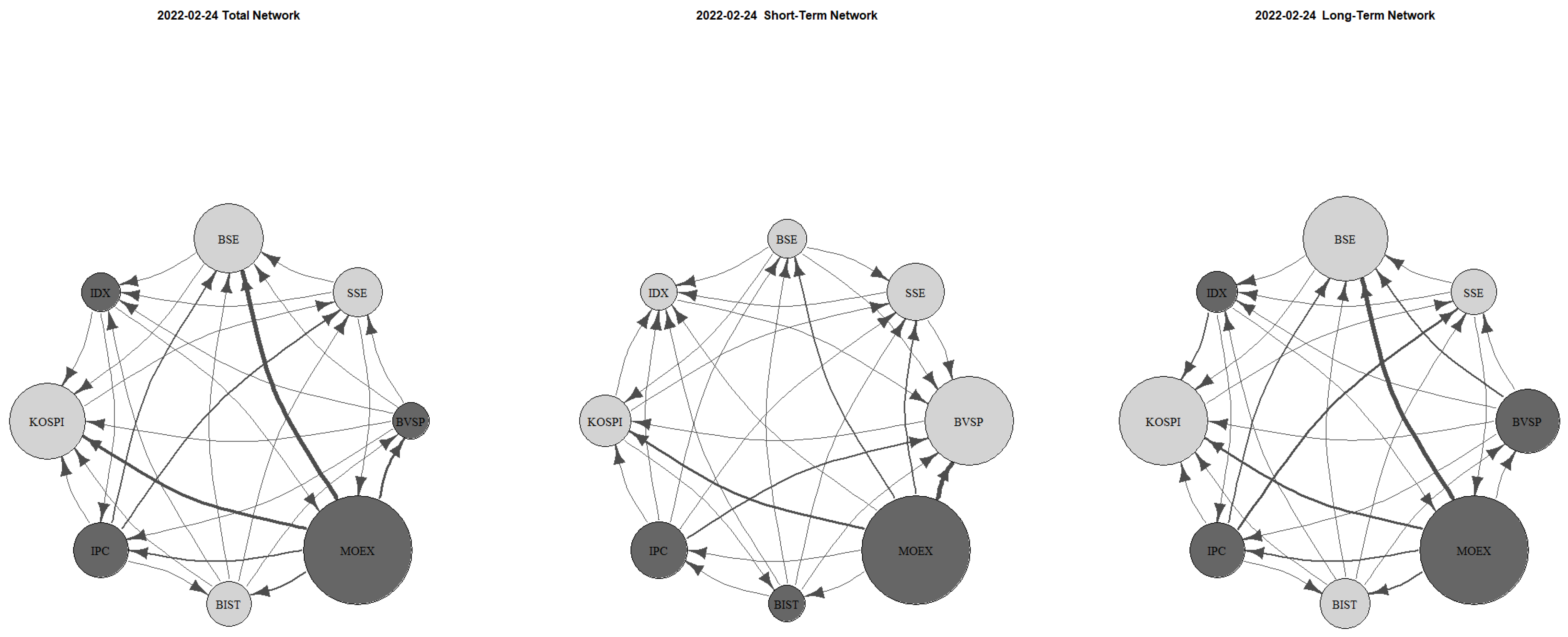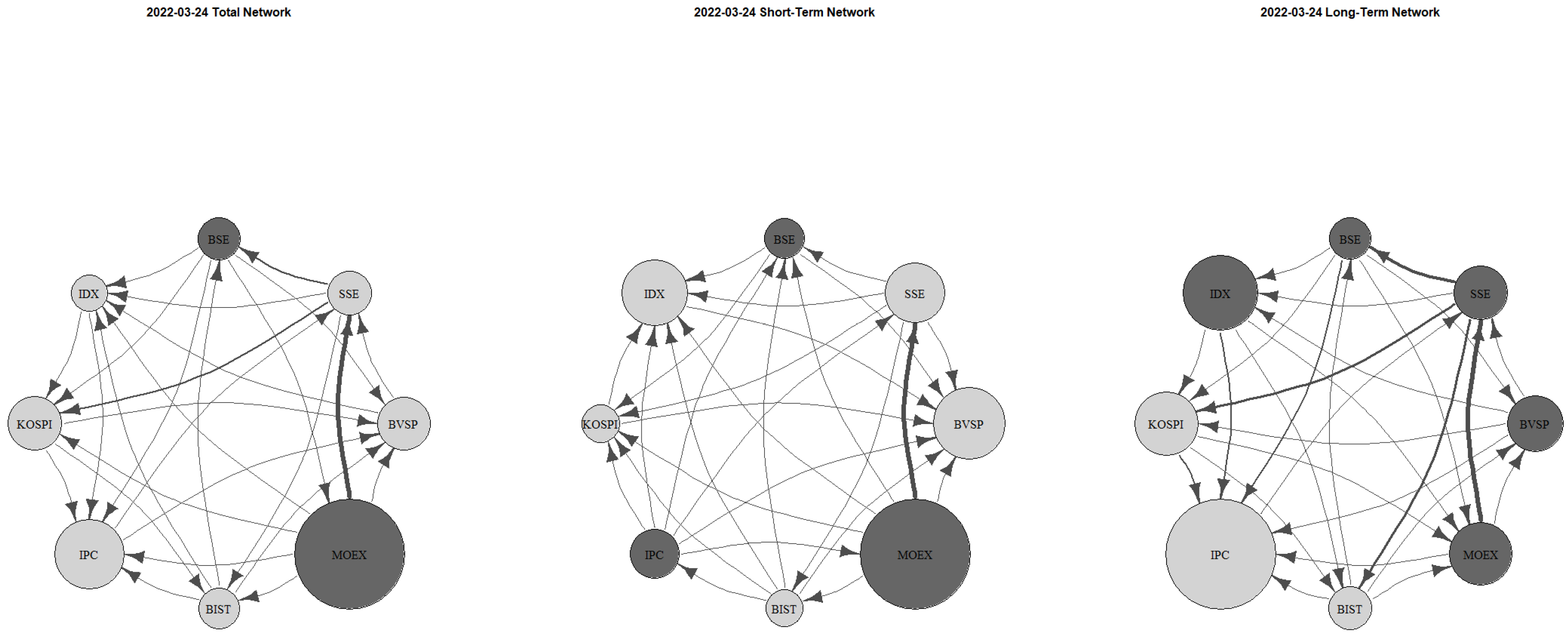2.3. Frequency-Based Tvp-Var Volatility Connectedness
Baruník and Křehlík [
25] expanded the financial connectedness framework initially developed by Diebold and Yilmaz [
55,
56,
57] by introducing a frequency-based methodology that captures dynamic market relationships over different time horizons. The pioneering study of connectedness analysis, Diebold and Yilmaz [
55], used a connectivity measure based on Cholesky decomposition for VAR model residuals. This orthogonalization method is sensitive to the order of variables and requires the assumption of structural constraints in the model, for example, a hierarchical order of influence among variables. Later, Diebold and Yilmaz [
56] adopted the generalized VAR approach developed by Pesaran and Shin [
58] in order to be insensitive to the order of variables; this method is based on the order-independent generalized prediction error variance decomposition (GFEVD).
Despite this advancement, both the Cholesky-based approach and the generalized approach use the assumption that the model parameters remain constant over time. When a dynamic structure is desired, VARs are usually estimated in different sub-periods with the rolling window technique, and the connectedness index is obtained over this rolling window. Using a sliding window, however, brings other problems: The window length needs to be determined arbitrarily, and this choice can seriously affect the results. For example, a narrow window selection can make the model parameters too volatile and overreact to shocks, while a wide window selection can over-smooth the changes and soften the important effects. In short, fixed parameter VAR models (even if they use generalized FEVD) are insufficient to fully reflect the fluctuations that occur in the relationships over time, especially when markets go through turbulent periods.
While Diebold and Yılmaz relied on fixed-parameter models that assume a time-invariant structure, financial markets exhibit inherent volatility and structural shifts that require a more flexible approach. To address this limitation, Baruník and Krehlik [
25] proposed a method that decomposes connectedness into short- and long-term components, allowing for a more refined analysis of how financial shocks propagate.
Building on these advancements, Antonakakis et al. [
59] developed a time-varying parameter (TVP) framework, culminating in the TVP-VAR model, which accommodates evolving relationships within financial networks. Unlike fixed-parameter models, the TVP-VAR approach adapts to changing market conditions, making it particularly valuable during financial crises, macroeconomic uncertainty, and structural transitions. An important advantage of this methodology is that it eliminates the need for the rolling-window estimation required in traditional Cholesky-based and generalized VAR models, thereby preserving data integrity and minimizing data loss.
Additionally, the TVP-VAR framework enhances the estimation of variance-covariance structures by capturing time-dependent parameter variations with greater precision. Given these methodological strengths, the frequency-based TVP-VAR model is widely used to examine how financial shocks unfold over different time horizons. By decomposing variance based on frequency, this approach offers a more comprehensive view of market interdependencies, revealing that while short-term shocks generate immediate volatility fluctuations, their long-term effects can be more persistent.
Our study follows the methodology of Huang et al. [
60], who utilize the TVP-VAR model to decompose volatility dynamics into their respective components, thereby enhancing the understanding of market risk by distinguishing between short-term and long-term fluctuations. According to the authors, short-term volatility primarily reflects temporary market disruptions and corrections, whereas long-term volatility captures more structural transformations within financial markets. The segmentation of volatility across different time horizons significantly improves risk management and strategic decision-making by allowing for a more precise assessment of market fluctuations. The frequency-based TVP-VAR approach builds upon the foundational work of Diebold and Yilmaz [
55,
56], Baruník and Křehlík [
25], and Antonakakis et al. [
59], with Huang et al. [
60] further refining its application within the analytical framework of this study.
In light of these methodological advancements, the TVP-VAR-based connectedness approach offers several distinct advantages: (i) its calculations are independent of the ordering of variables, (ii) it is well-suited for low-frequency datasets, and (iii) it exhibits robustness and reduced sensitivity to outliers. The frequency-domain connectedness method relies on the spectral representation of the TVP-VAR model, which estimates the interdependence of financial variables at different frequencies by applying Fourier transforms to impulse-response functions. This approach utilizes the full spectral range, thereby offering deeper insights into the indirect causal relationships among financial variables. Additionally, enhancements such as the incorporation of forgetting factors within the TVP-VAR model and the implementation of a Kalman filter improve the adaptability of the variance-covariance matrix.
These methodological refinements align with the framework proposed by Koop and Korobilis [
61,
62], which employs both VAR and exponentially weighted moving average (EWMA) forgetting factors. In their seminal 2020 paper, Antonakakis and his colleagues investigated the role of forgetting factors in time-varying parameter vector autoregression (TVP-VAR) and Exponentially Weighted Moving Average (EWMA) models, highlighting their importance in determining the weight assigned to historical data as new information becomes available. To assess the optimal parameter choice, they conducted a simulation study, systematically varying forgetting factors within the range of 0.96 to 0.99. Their findings revealed that a forgetting factor of 0.99 for TVP-VAR and values between 0.96 and 0.99 for EWMA minimized estimation errors, thereby enhancing model performance.
Drawing from these insights, the present study adopts a 0.99 forgetting factor for both TVP-VAR and EWMA, ensuring greater computational efficiency within the Kalman filter framework. Beyond parameter selection, Antonakakis et al. [
59] also explored the robustness of TVP-VAR estimates concerning different Bayesian prior specifications, recognizing that Bayesian estimation techniques necessitate prior assumptions. Their analysis incorporated uninformative priors, informative priors, and 500 randomly generated Minnesota priors to assess whether prior selection influenced estimation outcomes.
The results demonstrated that after approximately 50 iterations of coefficient updates, prior selection had no significant impact on model estimates, reinforcing the stability of their findings [
63,
64]. This robustness-check underscores the reliability of TVP-VAR models in financial connectedness research, particularly in the context of return and volatility spillovers. We obtain the results utilizing the R programming language (version 4.3.3) and the “ConnectednessApproach” package (version 1.0.4) developed by Gabauer [
65].
Based on these principles, the Bayesian Information Criterion (BIC) indicates that the TVP-VAR (2) model is the most suitable specification for this analysis. The structure and key properties of the TVP-VAR (2) model are outlined as follows:
In the model, we have expressed in matrix form above the properties of vectors and related matrices are listed as follows: is a vector of endogenous variables at time t, wherein k denotes the number of variables (i.e., stock market volatility series for different countries). is a stacked vector of lagged endogenous variables, so The vector has dimension . is a dimensional time-varying parameter matrix, whose elements evolve over time. Each row of represents the dynamic response of a variable to its own and other variables’ past values. is a dimension vector of error terms, assumed to be normally distributed with a time-varying variance-covariance matrix . is a white noise vector of dimension with zero mean and a time-varying variance-covariance matrix . Also, matrices and are time-varying variance-covariance matrices of dimension and , respectively. has dimension . This matrix and dimensional structure provide a comprehensive framework for analyzing time-varying relationships within the model.
The Diebold and Yılmaz connectedness methodology is fundamentally based on the Generalized Forecast Error Variance Decomposition (GFEVD), which is derived from the vector autoregressive framework. The theoretical foundation of this approach originates from the work of Koop et al. [
66] and Pesaran and Shin [
58], who formulated GFEVD within the context of the Wold representation theorem. Given this foundation, the first step in implementing the methodology involves transforming the estimated TVP-VAR model into its TVP-VMA representation using the following equation:
where
is an identity matrix.
Following this transformation, the impact of a shock in one variable on another can be systematically analyzed. The TVP-VMA representation enables the assessment of shock transmission from variable
i to variable
j, capturing both its magnitude and direction across different time horizons. Long et al. [
67] advocate for the use of GFEVD over its orthogonal counterpart, emphasizing that its results remain entirely invariant to the ordering of variables. Additionally, Wiesen et al. [
68] argue that GFEVD is the preferred approach when a well-defined theoretical framework is unavailable, as it allows for a more flexible identification of the error structure. This perspective informs the methodological choices in this study (Time-domain connectivity measures are not reported in this section; for a detailed discussion on these measures, readers may refer to Huang et al. [
60] and Long et al. [
67]).
It is also important to note that frequency-domain connectedness measures serve as direct analogues to their time-domain counterparts, offering a complementary perspective on market interdependencies. The analysis herein is performed using the frequency response function
, where
i represents the imaginary unit of a complex number and ω represents the frequency. This function provides a transition to the spectral density analysis of
at frequency ω. The spectral density function
facilitates the Fourier transform of the time-varying parameterized infinite-order Vector Moving Average (TVP-VMA(∞)) model. This framework enables the calculation of frequency-based GFEVD by incorporating spectral density insights as follows:
To sum up whole frequencies in a given range of interest, the equation is used. Here d is defined as the interval (a, b) where both a and b fall in the spectrum (−π, π) such that . Thus, the frequency connectivity metrics can be summarized as follows:
Total Directional Connectedness to Others (TO) quantifies the extent to which a shock in variable
j influences all other variables in the system and is formulated as follows:
Total Directional Connectedness from Others (FROM) measures the aggregate influence exerted by all other variables on variable
j reflecting its exposure to external shocks within the system and is defined as follows:
Net Total Directional Connectedness (NET) determines whether a variable serves as a net transmitter or receiver of shocks within the network. It is computed by subtracting the effect of variable
j on others from the effect of others on
j. A positive NET value (NET > 0) indicates that
j acts as a dominant transmitter, propagating volatility spillovers throughout the network. Conversely, a negative NET value (NET < 0) signifies that j is primarily influenced by external shocks, functioning as a net receiver and is denoted as follows:
Total Connectedness Index (TCI) quantifies the overall level of interconnectedness within a network, capturing both static and dynamic relationships. A higher TCI value indicates a more integrated network, where multiple nodes exhibit strong linkages. This implies that variables within the system are highly interdependent, meaning that a shock or fluctuation in one variable propagates throughout the network, influencing others, and TCI is formulated as follows:
Net Pairwise Connectedness (NPDC) measure quantifies the bi-directional nexus between
j and
i by subtracting the effect of variable
j on variable
i from the effect of variable
i on variable j. If
(
) then it means that variable
j is dominant over variable
i or vice versa.
Gabauer [
69] argues that NPDC is an insufficient metric to explain the intensity of bilateral connectedness. For that matter, the author introduced the Pairwise Connectedness Index (PCI) metric, which shows the strength of the binary relationship in the connectivity analysis by decomposing the TCI. While TCI quantitatively determines the overall connectivity of a system, PCI specifically measures the connectivity between pairs of variables within the system. PCI is expressed as a percentage and takes values between 0 and 1. Here, as the PCI value approaches 1, it indicates a strong connection between two variables, and as it approaches 0, it indicates a lack of connection, and the following equation can be harnessed to calculate PCI metrics:
Our study aims to unearth the existence of spillover effects in specific frequency bands by combining frequency connectedness measurements across specific intervals, thereby enhancing the understanding of market dynamics and highlighting the complex relationships among financial factors across different time horizons.
2.3.1. Average Total Connectedness Index
Table 2 presents the results of the Diebold-Yılmaz connectedness analysis applied to the financial markets of EAGLE economies, deconstructing financial spillovers into total, short-term, and long-term effects. The findings emphasize the interconnected nature of financial markets, illustrating how shocks originating in one asset class propagate across the network.
The Total row quantifies the aggregate spillover effect received by each asset (column) from all other markets, where a higher value signals greater external shock exposure. Conversely, the Total column represents the extent to which an asset contributes to overall system-wide volatility transmission with higher values indicating a stronger role as a systemic risk propagator. The Inc.Own measure accounts for both an asset’s internal volatility and the external variance it absorbs from interconnected markets, reflecting its combined internal and external volatility exposure.
To further dissect financial interdependencies, the NET measure calculates the difference between received and transmitted volatility spillovers. Positive values indicate that a market acts as a net transmitter of shocks, exerting influence on other financial systems, whereas negative values classify it as a net receiver, absorbing rather than propagating volatility. Complementing this, the NPDC measure assesses an asset’s direct financial linkages, determining whether it primarily functions as a shock transmitter or receiver within the global network.
The decomposition into short-term and long-term spillover components provides deeper insights into the temporal nature of volatility transmission. The Short-Term FROM/TO and Long-Term FROM/TO measures function similarly to the total connectedness framework but differentiate between immediate, reactive market movements and structurally persistent financial linkages. This segmentation enhances the precision of financial contagion analysis, revealing how market dependencies evolve over different time frames and informing both risk assessment and policy interventions.
From the table, it is evident that 41.07% of the forecast error variance in the examined markets stems from interconnected financial relationships, highlighting the degree of systemic risk transmission within the network. Latin American markets, particularly BVSP (Bovespa, Brazil) and IPC (Indice de Precios y Cotizaciones, Mexico), emerge as the most significant volatility spreaders in the system. The Total TO values for BVSP (59.46%) and IPC (58.34%) confirm their central roles in shaping global volatility dynamics, acting as primary conduits for financial contagion. Conversely, SSE (Shanghai Stock Exchange, China) and IDX (Indonesia Stock Exchange, Indonesia) exhibit the highest Total FROM values (66.2% and 52.91%, respectively), indicating that these markets are highly susceptible to external shocks, which further suggests that SSE and IDX function as volatility receivers, absorbing rather than transmitting systemic risk. Contrarily, MOEX (Moscow Exchange, Russia), with the lowest Total FROM value (27.75%), appears to operate in a relatively isolated manner, exhibiting lower dependence on external volatility fluctuations. However, its NET value (2.29%) suggests that it still plays a minor role in transmitting volatility within the system. Further analysis of NET values reinforces the dominance of BVSP (19.07%) and IPC (8.69%) as key volatility spreaders, confirming their systemic influence in global volatility transmission. Meanwhile, SSE (−13.79%) and IDX (−7.22%) display the lowest NET values, affirming their roles as net volatility absorbers rather than propagators. The NPDC measure, which quantifies two-way volatility linkages, highlights BVSP (7) and KOSPI (Korea Composite Stock Price Index, South Korea, 5) as the most interconnected markets, reinforcing their pivotal position in the global financial network. In contrast, SSE (1) registers the lowest NPDC value, indicating that it functions as a more passive market in volatility transmission.
The Short-Term FROM values measure market susceptibility to external shocks. The highest values are observed in BSE (10.38%), BVSP (9.39%), and IPC (8.77%), suggesting that these markets exhibit high sensitivity to short-term disruptions. Conversely, BIST (4.64%) and MOEX (5.95%) display lower sensitivity, implying that they operate with a relatively more insulated short-term structure. The Short-Term TO values provide insights into each market’s contribution to short-term volatility transmission. The strongest spillover transmitters are BSE (10.63%), IPC (10.62%), and IDX (9.99%), whereas SSE (3.11%) and MOEX (5.3%) exhibit lower TO values, suggesting a more constrained role in short-term volatility propagation.
Additionally, the Inc. Own measure, which accounts for an index’s internal variance and received spillovers, is highest for MOEX (41.12%), underscoring the Russian market’s strong internal influence and heightened sensitivity to external conditions. Examining NET values, IDX (3.59%) and IPC (1.86%) emerge as short-term net volatility transmitters, whereas SSE (−4.6%) and BVSP (−0.75%) function as net receivers, indicating greater susceptibility to external shocks. Furthermore, the NPDC measure identifies IDX (7) and IPC (5) as the markets with the highest number of direct short-term volatility connections, signifying their importance in global financial integration. In contrast, SSE (1) and BIST (2) maintain fewer short-term linkages, highlighting their relatively more insulated position in short-term volatility transmission.
Over extended periods, MOEX (21.8%) appears least affected by external volatility, reinforcing its relatively independent role in global financial markets. Latin American markets, however, continue to dominate long-term volatility transmission, with BVSP (50.82%) and IPC (47.72%) exhibiting the highest TO values, confirming their long-term systemic importance as major volatility spreaders. In contrast, SSE (16.89%) and BIST (21.73%) report the lowest TO values, suggesting that their influence on long-term volatility transmission is relatively limited. The NET values further highlight BVSP (19.82%) and IPC (6.83%) as the strongest long-term volatility transmitters, whereas SSE (−9.18%) and IDX (−10.81%) emerge as the most prominent volatility receivers, indicating their greater exposure to external long-term financial shocks. Meanwhile, KOSPI (0.69%) remains largely isolated, with minimal long-term volatility transmission. In terms of bidirectional long-term linkages, BVSP (7) and KOSPI (5) maintain the highest NPDC values, reinforcing their interconnected nature within global volatility networks. Conversely, SSE (1) and BIST (2) continue to exhibit limited long-term interdependencies, underscoring their more passive role in global volatility dynamics.
The results highlight Latin American markets, particularly BVSP and IPC, as crucial players in global volatility spillovers, reinforcing their significance in international financial networks. By contrast, Chinese and Indonesian markets (SSE and IDX) are more vulnerable to external volatility shocks yet exhibit limited capacity to transmit systemic risk to other financial markets. Meanwhile, Russian, South Korean, and Turkish markets (MOEX, KOSPI, and BIST) appear less integrated into global volatility spillovers, with low FROM and TO values, suggesting weaker global financial linkages. From an investment standpoint, markets with high NPDC and positive NET values (BVSP and IPC) present high-return opportunities but also carry substantial risk exposure due to their role as volatility spreaders. Conversely, markets with low NPDC and negative NET values (SSE and IDX) may be more suitable for hedging strategies, as they primarily absorb rather than transmit volatility.
2.3.2. Dynamic Total Connectedness Index
Figure 2 illustrates the Total Connectedness Index (TCI) derived from the dynamic frequency connectivity analysis, providing a comprehensive measure of financial interconnectedness and systemic risk transmission across selected assets. As a key indicator of volatility propagation, TCI quantifies the extent to which financial shocks disseminate throughout the network, offering critical insights into the stability of global markets.
To interpret the most significant fluctuations in TCI, it is imperative to contextualize them within major global events that unfolded between 2019 and 2024. The dynamic nature of TCI emphasizes the responsiveness of financial linkages to economic crises and external shocks, reinforcing its role as a leading metric for assessing systemic risk. The graphical representation reveals considerable fluctuations over time, characterized by sharp peaks and troughs that signal shifts in financial interdependence.
Periods of heightened TCI values correspond to phases of elevated systemic risk, where financial assets exhibit strong co-movement, often triggered by global economic disruptions, geopolitical tensions, or policy changes. Short-term surges in TCI generally reflect immediate market reactions to external shocks, while sustained long-term interdependencies suggest deeper structural financial linkages within the system.
Monitoring TCI fluctuations is particularly relevant for investors and policymakers, as elevated levels act as early warning signals of financial instability. During financial crises, short-term volatility spillovers tend to dominate, capturing abrupt market responses to disruptions. In contrast, long-term spillovers provide valuable insights into persistent structural vulnerabilities, guiding the formulation of risk mitigation strategies and enhancing macro-prudential oversight. By distinguishing between temporary market shocks and enduring systemic risks, TCI serves as a vital tool in navigating financial uncertainty and reinforcing market resilience.
The figure illustrates significant peaks in the Total Connectedness Index (TCI), particularly in early 2020 and early 2022, with values exceeding 60 during these periods. While both short-term and long-term interconnectedness also rise, their fluctuations are less pronounced compared to total TCI. From the second half of 2020 onward, TCI exhibits a gradual downward trend, stabilizing at lower levels throughout 2023. This decline suggests a weakening of global financial interconnectedness, with market dynamics increasingly shaped by regional factors rather than broad-based global shocks.
The surge in early 2020 aligns with the onset of the COVID-19 pandemic, which caused severe disruptions in economic and financial systems worldwide. Rising global uncertainty and market volatility heightened financial interdependence, reflected in the sharp increase in TCI during this period. The escalation in short-term TCI underscores immediate market responses to pandemic-induced shocks, whereas the sustained rise in long-term TCI suggests that the crisis had lasting economic implications, influencing macroeconomic fundamentals beyond the initial shock.
A similar pattern emerges in early 2022 with the Russia–Ukraine war, which profoundly impacted energy and commodity markets, particularly those with direct exposure to European and Russian trade flows. Uncertainty surrounding global energy supply chains drove heightened market volatility, leading to another surge in Total TCI. This increase illustrates how geopolitical risks propagate through financial networks, amplifying systemic volatility across interconnected markets. Economies heavily reliant on energy price stability, such as Russia’s MOEX, absorbed significant external shocks, reinforcing the rise in TCI during this period.
By 2023, TCI stabilizes at lower levels, reflecting the gradual dissipation of pandemic-related disruptions, a relative recovery in global economic conditions, and a shift toward more localized financial dynamics. The decline in Total TCI indicates a weakening of global financial interdependence, with volatility increasingly driven by domestic and regional factors rather than systemic global shocks. The persistently low short-term TCI values in 2023 and beyond further suggest that sudden global shocks exert a diminishing influence, with financial movements primarily dictated by localized economic and geopolitical developments. Conversely, long-term TCI fluctuations continue to reflect the persistent influence of macroeconomic trends and policy decisions on market volatility. For example, the lasting economic consequences of the pandemic and fluctuations in global energy prices remain key determinants of financial market stability. Peaks in long-term TCI highlight the role of fundamental macroeconomic variables, including fiscal policies, interest rate adjustments, and shifts in global trade dynamics, in shaping extended volatility cycles.
2.3.3. Net Total Directional Connectedness
Figure 3 illustrates the dynamic Net Total Directional Connectedness (NET) indices, capturing the evolving transmission and absorption of volatility across financial markets. Consistent with connectedness theory, global crises and country-specific economic developments determine whether a market serves as a volatility transmitter or receiver. As seen in the Total Connectedness Index (TCI) analysis, NET indices highlight two major global events: the COVID-19 pandemic (March 2020) and the Russia–Ukraine war (February 2022). Both crises triggered sharp volatility surges, fundamentally altering financial interconnectedness.
Amongst the analyzed markets, BVSP emerges as the strongest volatility transmitter, reaching a peak NET value of 210.76% on 18 March 2020. This extreme figure underscores Brazil’s role in propagating financial shocks, largely due to its dependence on energy and agricultural commodities. Volatility spillovers intensify during global crises when commodity price fluctuations exacerbate systemic uncertainty. The persistently high long-term NET values of BVSP following the COVID-19 pandemic further confirm its role as a major volatility spreader, particularly through commodity price shocks. However, after the Russia–Ukraine war, BVSP’s NET values stabilized near zero, suggesting reduced volatility transmission and greater resilience. A similar transmission pattern is evident in IPC, portraying high sensitivity to global economic shocks due to its strong energy and commodity market linkages. This dependency results in consistently positive NET values, positioning IPC as a volatility transmitter across both short- and long-term horizons. The COVID-19 pandemic reinforced IPC’s role in systemic risk transmission, mirroring BVSP’s behavior.
The parallel volatility patterns in Latin American markets indicate a regional spillover effect, where external shocks spread rapidly across economies with commodity-driven financial structures. In contrast, SSE and IDX consistently exhibit negative NET values, indicating that they absorb rather than transmit volatility. The Shanghai Stock Exchange has functioned as a volatility receiver, reflecting China’s controlled financial structure and limited external exposure. The negative NET values of SSE over long time horizons suggest that volatility in the Chinese market is largely externally driven rather than rooted in domestic instability. Similarly, IDX remains highly susceptible to shocks in energy and raw material prices, reinforcing its volatility-receiving role. While IDX occasionally exhibits positive NET values in the short term, the prevailing trend confirms its function as a volatility absorber rather than a spreader within the global financial system.
Unlike markets that consistently function as either volatility transmitters or receivers, BIST assumes a dual role, exhibiting characteristics of both at different points in time. A significant exchange rate shock in December 2021 triggered a sharp increase in BIST’s NET values, positioning it as a short-term volatility transmitter. This spike was primarily driven by exchange rate fluctuations, monetary policy adjustments, and investor uncertainty, which led to substantial disruptions in local financial markets. Türkiye’s volatility dynamics were further shaped by the Kahramanmaraş earthquakes in February 2023, which introduced additional short-term financial shocks. However, this effect remained largely localized, suggesting that BIST’s role in systemic volatility transmission is contingent on the nature of the shock. Over longer time horizons, Türkiye exhibits a more integrated financial structure, making it more susceptible to external volatility spillovers rather than serving as a primary source of global systemic risk.
The Russia–Ukraine war of February 2022 marked a pivotal shift in the volatility dynamics of MOEX. On the day the conflict began, MOEX recorded a sharp increase in NET values, establishing itself as a significant volatility transmitter. This surge reflects the immediate impact of geopolitical uncertainty, capital outflows, and heightened financial risk perceptions surrounding Russian assets. However, the post-war imposition of economic sanctions and the partial closure of the Moscow Exchange fundamentally altered MOEX’s role in global financial networks. As a result, MOEX transitioned into a volatility-receiving market, becoming more vulnerable to external shocks rather than actively spreading systemic risk. This transition underscores the profound effects of geopolitical developments on financial market stability and connectedness.
BSE has demonstrated positive NET values across both short- and long-term horizons, highlighting its growing influence as a volatility transmitter. India’s increasing role in global trade, foreign investment flows, and energy markets has amplified its importance in financial interconnectedness. Notably, BSE’s NET values intensified during the COVID-19 pandemic, reflecting its heightened sensitivity to commodity price fluctuations and global market uncertainty. This trend suggests that as India continues to integrate into global financial networks, its role as a source of systemic volatility spillovers is likely to expand, particularly during periods of economic distress.
Ultimately, the findings reveal the following key patterns: Markets exhibiting positive NET values, such as BVSP, IPC, and BSE, serve as primary sources of systemic volatility, particularly due to their exposure to commodity price fluctuations and global economic uncertainty. Markets with negative NET values, including SSE and IDX, predominantly absorb external shocks rather than transmit them, reflecting their structural characteristics and economic policies. Türkiye’s BIST alternates between volatility transmission and absorption, with short-term spikes driven by domestic shocks (e.g., exchange rate fluctuations and natural disasters) and long-term integration with global financial trends. MOEX’s shift from volatility transmitter to receiver illustrates how geopolitical events and economic sanctions can redefine a market’s role in systemic risk transmission.
2.3.4. Dynamic NPDC and PCI Analyses
This section examines the findings from the dynamic NPDC and PCI analyses, presented in
Figure 4 and
Figure 5, respectively. These analyses provide detailed insights into volatility spillovers and market interactions in global financial systems. Bilateral market connections fluctuate over time but become particularly pronounced during periods of crisis. Notably, Brazil’s BVSP index stands out as a dominant volatility spreader in both NPDC and PCI analyses. A persistent and strong interaction is observed between BVSP and Mexico’s IPC index, reflecting regional integration and a shared commodity-based economic structure. Similarly, Brazil’s connection with India’s BSE index exhibits a positive relationship due to trade in commodities. However, its ties to Asian markets such as China (SSE) and Indonesia (IDX) are weaker. PCI values for these market pairs remain low, with temporary increases observed only during global crises, such as the COVID-19 pandemic. NPDC findings further support this pattern: while Brazil transmits volatility to China and Indonesia, it receives minimal volatility from these economies. This reflects China’s controlled financial structure and Indonesia’s vulnerability to external shocks.
Russia’s MOEX index underwent a notable shift during the 2022 Russia–Ukraine war. During this period, MOEX experienced a surge in PCI values, briefly acting as a volatility transmitter. However, following the imposition of sanctions and market restrictions, MOEX reverted to a volatility-receiving role in the long term. A similar dynamic is observed between Türkiye’s BIST index and MOEX. Given Russia’s influence in energy markets and Türkiye’s reliance on energy imports, PCI values between the two markets rose significantly during crisis periods. NPDC graphs further confirm that Türkiye alternates between being a volatility receiver and transmitter, depending on market conditions.
In Asian markets, China (SSE) and South Korea (KOSPI) exhibit greater sensitivity to external shocks and generally function as volatility receivers in NPDC analyses. However, energy-based connectivity is evident between China and Russia, particularly during crises, as reflected in PCI spikes. By contrast, South Korea and Mexico (IPC) exhibit minimal financial interconnectedness, likely due to fundamental differences in their economic structures. While South Korea’s economy is driven by technology and manufacturing, Mexico’s is more commodity- and energy-dependent, resulting in low PCI and NPDC values between the two markets.
When evaluated together, NPDC and PCI analyses provide a clearer understanding of how market connectivity evolves in both directionality and intensity. While positive NPDC values indicate the direction of volatility spillovers between specific market pairs, PCI quantifies the overall strength of these linkages and their fluctuations during crisis periods. Global shocks such as the COVID-19 pandemic and the Russia–Ukraine war have triggered temporary surges in PCI values, making inter-market relationships more pronounced. Latin American markets display stronger financial integration, whereas Asian markets remain more fragile and highly sensitive to external shocks. A closer examination of Brazil’s BVSP index highlights term-dependent variations in its volatility spillover effects. Over the long term, BVSP consistently exhibits dominant NPDC values, reinforcing its role as a major volatility transmitter. However, when considering total values, BVSP acts as a volatility receiver relative to KOSPI. Furthermore, BVSP and IPC register the highest average PCI values in the financial network, confirming their significance as key volatility spreaders. These findings underscore the importance of distinguishing between short-term and long-term spillover effects in understanding the broader dynamics of financial interconnectedness.
2.3.5. Average NPDC and PCI Analyses
Table 3 presents the NPDC and PCI values, which quantify both the direction and intensity of market interconnectedness. It is evident that BVSP acts as a dominant volatility transmitter across all markets, with IDX (4.20%) and BSE (4.19%) experiencing the highest spillovers, highlighting BVSP’s influence on Asian (India and Indonesia), Russian (MOEX), and Latin American (Mexico) markets. In contrast, SSE (China) receives the least volatility (1.06%), and KOSPI (1.48%) and BIST (1.70%) register relatively low NPDC values, indicating weaker transmission to these markets. PCI values further illustrate BVSP’s strongest financial linkages, particularly with Mexico (37.16%), India, South Korea, and Indonesia. The exceptionally high PCI value with Mexico suggests a strong degree of integration, likely due to geographic proximity and shared geopolitical risks. Conversely, MOEX (13.07%), BIST (15.48%), and SSE (15.95%) exhibit weaker connectivity with BVSP, reinforcing the notion that Brazil’s influence on Russia is more indirect, driven by commodity and energy price interactions rather than direct financial ties. Given that BVSP spreads the most volatility to Indonesia, India, and Russia, investments in these markets may be particularly sensitive to Brazil-driven fluctuations.
Since Mexico maintains the highest PCI value with BVSP, these two markets tend to move in tandem. India, Indonesia, and South Korea, which also exhibit high PCI values with BVSP, may serve as regional diversification options, linking Latin American and Asian markets. In contrast, China and Türkiye, which show weak PCI connections to BVSP, may provide portfolio balance and risk mitigation benefits. Short-term NPDC dynamics suggest BVSP is more passive against markets with strong long-term and aggregate bilateral connectivity. Markets that act as volatility receivers with high PCI values include BSE (−0.39% | 9.59%), KOSPI (−0.44% | 6.17%), IDX (−0.76% | 6.08%), and IPC (−0.25% | 8.00%). In contrast, BVSP dominates volatility transmission to BIST, SSE, and MOEX in the short term, making investments in these markets more exposed to Brazil-driven fluctuations. Since Türkiye and Russia exhibit very low PCI values, they tend to operate independently from BVSP, positioning them as alternative diversification assets. Meanwhile, Brazil’s strong correlation with India and Mexico suggests that these markets exhibit parallel movements, potentially creating arbitrage opportunities for short-term investors monitoring Brazil-India and Brazil-Mexico price dynamics.
KOSPI exhibits strong connectivity with IDX (−1.29% | 37.99%), where it acts as a volatility receiver, while BSE (0.34% | 37.12%) is a transmitter with a high bilateral connection. Additionally, KOSPI maintains a relatively strong relationship with BVSP (−1.48% | 30.52%) and IPC (0.18% | 29.43%), while its ties to SSE (15.24%), BIST (12.50%), and MOEX (11.25%) are comparatively weaker. Overall, KOSPI is highly interconnected with BSE, BVSP, and IDX but exhibits limited linkages with MOEX and BIST in both the short and long term. Since IDX and BSE exhibit high PCI values, including them in the same portfolio may amplify risk. Conversely, markets with low PCI values, such as SSE, MOEX, and BIST, could serve as diversification assets in a KOSPI-based portfolio. Given that BVSP and IDX are the primary sources of long-term volatility for KOSPI, monitoring their interrelations is crucial for investment strategies.
IDX is one of the most affected markets by volatility transmission from IPC and BVSP, while it spreads volatility to KOSPI and SSE. In the short term, IDX transmits heightened volatility to BSE and IPC and continues to do so over the long term, maintaining a parallel pattern to short-term bilateral relationships. While IDX shares high volatility with BSE and IPC in the short term, its strongest long-term bilateral connections are with IPC and KOSPI. SSE, contrarily, demonstrates low connectivity across all markets. The lowest PCI value in total is observed between SSE and IDX (−1.23% | 8.81%), indicating minimal direct linkages.
SSE functions as a net transmitter only in relation to BIST, though this connection is negligible, with 0.01% NPDC and 1.54% PCI, suggesting that SSE and BIST have almost no financial interdependence in the short term. However, SSE dominates BIST in the long term. While BIST has the highest NPDC value in the short term, MOEX (−0.32% | 2.12%) remains largely disconnected from other markets, positioning it as a neutral market. The BIST-MOEX relationship can be attributed to geographical proximity and Türkiye’s dependence on Russian energy imports. While BIST dominates MOEX in the long term, it acts as a receiver in the short term. MOEX’s neutral position stems from its heavy reliance on internal factors, as reflected in its high internal PCI value of 49.9% in the short term. This underscores the dominance of Russia’s domestic market conditions over external influences, a factor further reinforced by geopolitical risks and international sanctions.
SSE’s low NPDC and PCI values suggest that it operates as a relatively independent market within the global financial network. While this insulation offers diversification benefits, it also limits arbitrage opportunities for investors. Capital controls and regulatory policies likely restrict SSE’s role in global market integration. Despite being one of the world’s largest exchanges by market capitalization, SSE functions differently from other major financial centers due to China’s strict capital market regulations, deep liquidity, and a predominantly local investor base. Unlike smaller, open economies, large exchanges with deep internal liquidity tend to be less vulnerable to global fluctuations. SSE’s low NPDC value reinforces its status as a self-contained financial ecosystem rather than a net volatility transmitter. Additionally, its relatively low PCI value further indicates that China’s stock market does not fully transmit or absorb global financial shocks, most likely due to capital controls. While global equity markets often exhibit strong correlations during major crises, China’s stock market might at times follow a more isolated trajectory.
2.3.6. Network Plots
In the network graphs presented in
Figure 6,
Figure 7,
Figure 8 and
Figure 9, dark gray nodes represent dominant volatility transmitters, while light gray nodes denote passive receivers. Arrows pointing toward a node indicate volatility reception, whereas arrows originating from a node signify volatility transmission. The thickness of the arrows reflects the strength of the relationship, while node size corresponds to the magnitude of contagion.
Figure 6 identifies BVSP (Brazil) as the largest node in the time domain, reinforcing its position as the primary driver of volatility transmission. Other significant transmitters include IPC (Mexico), MOEX (Russia), and KOSPI (South Korea), all represented as dark-colored nodes. Amongst these, MOEX exhibits strong contagion toward SSE (China), which functions as the largest receiver in the network. In the short term, IDX (Indonesia) emerges as the most dominant transmitter, while SSE remains the largest receiver. Notably, BVSP appears passive in the short term but reasserts its dominance in the long run. The most pronounced contagion effects are observed from MOEX to SSE across both short- and long-term horizons, while IPC and IDX maintain strong long-term connectivity. Meanwhile, BIST (Turkey) exhibits weak integration within the network and primarily functions as a volatility receiver.
On 11 March 2020, the day the World Health Organization declared the COVID-19 pandemic, Total TCI surged to 70.35%. It peaked at 73.99% (Short 7.04% + Long 66.95%) on 17 March 2020.
Figure 7 presents the network analysis for this date, highlighting BVSP as the dominant exchange in both short- and long-term horizons. Strong volatility transmission is observed from BVSP to BIST in the short term and to BSE and IDX in the long term, confirming that BVSP drives the network. Meanwhile, SSE remains the most passive market, consistently acting as a receiver against all exchanges, while IPC emerges as another key volatility transmitter.
Figure 8 depicts the network structure on the first day of the Russia–Ukraine war, while
Figure 9 illustrates bilateral network connectivity when MOEX reopened on 24 March 2022, following a temporary closure. These dates mark peak dynamic TCI values as systemic risk, which had declined post-pandemic, surged again with the onset of the conflict. MOEX led volatility transmission on both dates, with high spillovers to BSE (India) in the long term and to BVSP (Brazil) in the short term. As in previous observations, SSE remains a dominant receiver. When MOEX resumed trading, it once again acted as a major risk transmitter, with strong contagion to SSE in the short term. On this day, BVSP was a major volatility receiver, remaining passive against all markets.

